Hate is not a Laramie value. And either the word is sufficient or it is not. It is a strong word, a word of intolerance, a word that cannot be ignored when addressing the heinous crimes that put Laramie, Wyoming on the map. On November 14, 1998 members of the Tectonic Theater Project traveled to the small town and conducted interviews with the people of Laramie, the result of which became a tragically beautiful play known as The Laramie Project. On February 5, 2016— nearly 18 years later and still powerfully resonant and relevant to modern society as we know it— the Kensington Arts Theatre has taken this production and opened it for residents of the DMV to absorb. Directed by John Nunemaker, this striking and provocative theatrical experience shakes the core of the audience’s foundation as explores the events, reactions, and responses, to one of America’s most recognized hate crimes in recent history.
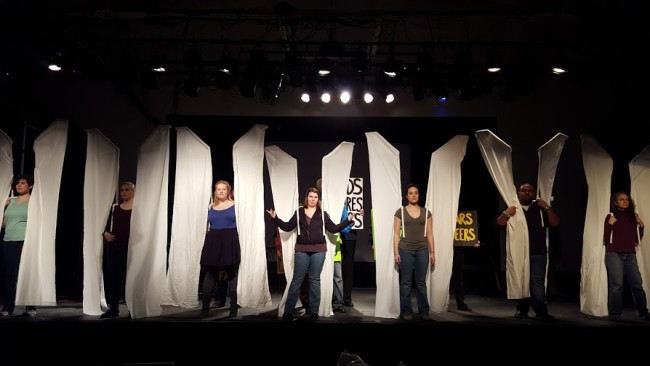
The tale itself is jarring enough. Director John Nunemaker keeps the truth of the story in its purest essence by not overcomplicating the production’s design elements. A simple hat or jacket is added as a demure accent to the performers’ clothing to add a visual aid component into the mix when it comes to character distinguishing as the actors take on multiple roles, including meta elements of being members of the Tectonic Theater Project, in addition to being people of Laramie. One might go so far as to say that this is almost unnecessary, save for the aesthetic it cultivates, because Nunemaker ensures that the performers are crisply unique and distinctive in their delivery of the varying characters.
Employing the use of projections, as designed by Multi-Media Artist Gabriel Macedo, again Nunemaker takes a light approach to infusing these images into the performance, using them only when they create a profound impact upon the spoken word as it unfurls. Macedo works with the notion of visual stimulation, particularly during the “diary entries” scene, exposing typed segments in fonts not dissimilar to handwriting upon the backdrop to further iterate the potency of these words in that moment. Macedo and Nunemaker work together to create striking visuals in precisely the right moments— the twinkling lights of Laramie at the end or the falling rain leading into the funeral scene, all of which come together in little moments of visual perfection without falling to heavily-handed on the production’s overall aesthetic.
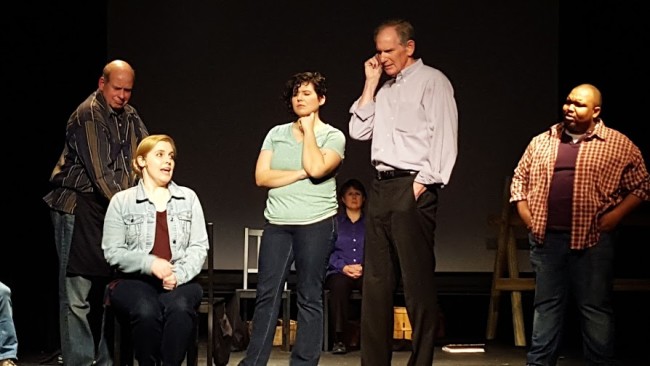
There is true beauty found in the simplicity of Lighting Designer Dan Patrick Leano’s work. Nothing more than a few basic solo spot cues that fade up and down at precisely the right moment in muted turns of warm and gentle, but it is notion of guided light that draws the focus to the actors and their speeches. Often times Nunemaker has blocked a trio of performers, speaking in segments as their stories interviews, and it’s Leano’s keen timing and precision of cue that creates this cinematic effect to their delivery. The rising and fading lights that occur throughout, but particularly in moments like these, triggers a sense of live-footage being blended into the mind’s eye and makes for a remarkable presentation consistently throughout the performance.
Director John Nunemaker brings little technological miracles to the stage, showcasing his expertise in the field of visual and mixed media. Again working with Macedo, the team employs the use of live-feed video recorders that stream moments of “reporter-style” action directly onto the backdrop. One of the most stirring occurrences of this device happens when the hospital spokesman makes his series of announcements regarding Matthew Shepard’s condition and ultimately his death; this harrowing nature of this moment is increased tenfold with the live feed projected on the backdrop, immersing the audience fully into the press-conference feel of it.
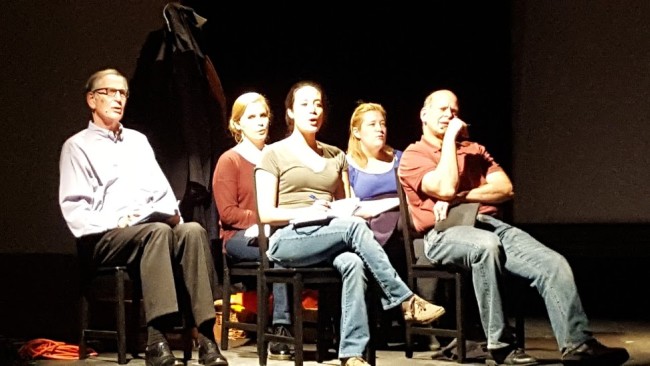
It’s Nunemaker’s keen understanding of how to block a show of this nature that really opens up the stage for a more fully authentic experience of the material being presented. His choice to keep all of the inactive players on stage in their chairs is a curious one, but not without its theatrical merit. The actors not in the scene sit still, mindfully present in their own bubbles of concentration until they appear actively in their scenes on the play. This, combined with the unique casting-approach Nunemaker has presented, puts a signature unique to KAT on the production that speaks to the caliber of talent within this community production that there is to be experienced.
The ensemble delivers a riveting performance. The source material is brilliant but brilliant work does not carry itself. The way the ensemble works together to define gripping moments, accentuating the emotional integrity through connective clarity, is stellar. Performances across the board are remarkable, everything from simple moments of discussing the journey of the Tectonic Theater Project company member experiences to the more deeply ingrained experiences of those real-life people that are being portrayed from Laramie. It cannot be stressed enough how truly earnest the performances are, not a trace of artifice in the production, allowing for this rich, moving stories and snippets of real life to come across fully to the audience in a most profound and striking fashion.
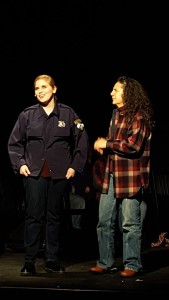
Congenial is an exceptional word that can be applied to many of the performances throughout the show, but particularly to the mother-daughter relationship experience between Marge (Susan S. Porter) and Officer Reggie Fluty (Lena Winter.) Porter delivers a raw salted-earth component to her portrayal of Marge, infusing this sandpapered character with true maternal love when it comes to fear and frustration regarding the circumstances surrounding Reggie’s involvement in the Matthew Shepard case. Winter, as the hopeful Fluty, reaffirms that there are good human beings left in the world, those that do without thinking to save the life of another because altruism is their base calling. Winter doubles, as many of the performers do, as one of the accused perpetrator’s girlfriends, an unsettling backwoods ignorance beaming through her character, which showcases her supreme versatility as a performer.
Clancey Yovanovich delivers similarly startling differences between her character portrayals, the most distinctive of the two being between the slightly chipper-voiced Zackie Salmon— a town lesbian— and the rogue and rough Romaine Patterson. As Patterson, Yovanovich gives a distinguished voice to the character that speaks with emotional integrity. Her scene following the funeral moment as she introduces the “Action Angels” is deeply profound and delivered with such simplicity that anyone who has ever wanted to take a stand for something they believe in can easily relate.
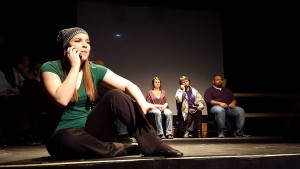
Zoe Bulitt, whose most memorable scene occurs during an earnest phone call with the minister’s wife (as played by Natalie McManus) is another performer who has an exceptionally impressive ability to make each of her characters feel different. It’s the deeply etched facial expressions that occur in the phone-conversation scene, as well as when Bulitt plays Catherine Connolly— expressing her outed lifestyle early on in Laramie— that really make her moments in performance worth watching. McManus shares similar facial expressivity but does a great deal of her emotional venting through pitch-change in her voice, particularly when the Minister’s Wife has a moment’s concession and changes her mind.
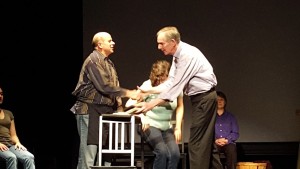
Stuart Rick and Bob Harbaum may appear to be “featured players” among the ensemble as they seemingly take on the most roles throughout the performance. Both Rick and Harbaum have distinctive presences on stage and bring a great deal of the show’s various accents to the foreground of the performance. Harbaum takes on the difficult role of playing Fred Phelps, easily earning the audience’s ire and loathing through his few words blasted soundly during those moments in protest. But it’s his work as the various police sergeants and detectives that bring his ability to create unique characters through accents and vocal intonation to the stage.
Even sharing a role, both Harbaum and Rick carry a great deal of the heavier moments of the show’s emotional turmoil on their shoulders. Rick is the harbinger of heartfelt sorrow when delivering one of the penultimate speeches of the performance as Dennis Shepard. Evocative, sorrowful, and convivial in its nature, Rick’s delivery of this scene rends the heart in twain with a swift knife. His portrayal of Father Schmit, Philip Dubois, and Moisès Kaufman are equally impressive and deeply rooted in the truth of the situation.
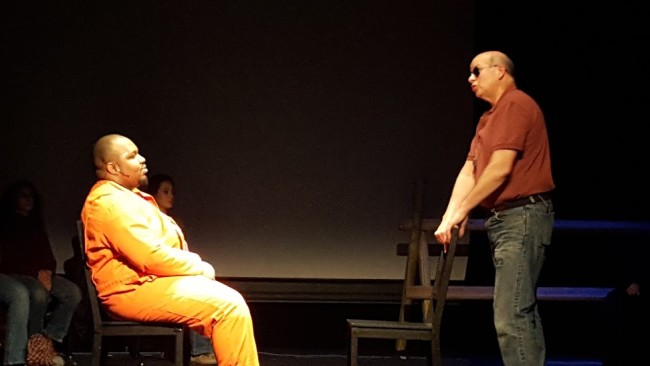
Standout performer Shaquille Stewart brings the audience to tears several times throughout the performance but takes it a step further by mastering one of the most burtal moments in the show. During his brief portrayal as Aaron McKinney, his articulation of the remorseless criminal is so vile and sharply demonstrated that it stirs up volatile nausea to witness such unrepentant hatred. A masterful life-force in the production, Stewart brings each of his characters to the stage as a distinctively different and unique flood of light, though each one is luminescently vibrant in their existence. His delivery of Aaron Kreifels (a role shared later in the story by Francisco Borja) is remarkably harrowing, a sharp juxtaposition of the emotions he draws forth when playing Aaron McKinney.
Emotionally charged to the point of pathos experienced in overdrive, this riveting production of The Laramie Project is not to be missed. Tickets are on sale now and should be purchased quickly as seating is limited and many performances are filling up quickly.
Running Time: Approximately 3 hours with one intermission
The Laramie Project plays through February 20, 2016 at Kensington Arts Theatre located in the Kensington Town Hall— 3710 Mitchell Street in Kensington, MD. For tickets call the box office at (206) 888-6642 or purchase them online.

